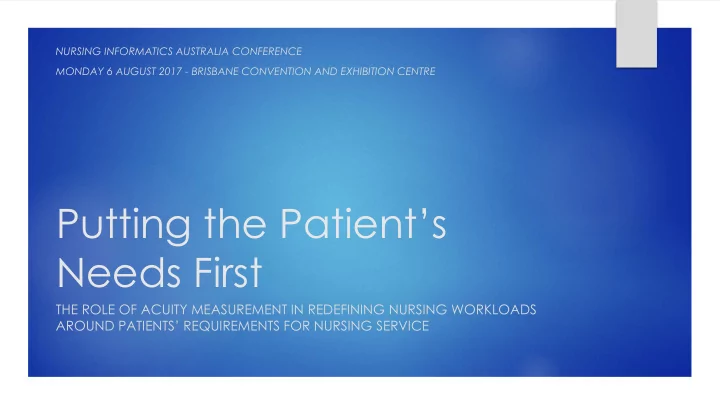

NURSING INFORMATICS AUSTRALIA CONFERENCE MONDAY 6 AUGUST 2017 - BRISBANE CONVENTION AND EXHIBITION CENTRE Putting the Patient’s Needs First THE ROLE OF ACUITY MEASUREMENT IN REDEFINING NURSING WORKLOADS AROUND PATIENTS’ REQUIREMENTS FOR NURSING SERVICE
2 Traditional methods Historic nursing labour hours per patient day Usually based on census calculation of patient days May be broken down on DRG Nurse:patient ratios Luke Hutley - support@trendcare.com.au
3 Workload distribution Generally divided between nurses based on number and proximity of patients Variable inclusion of clinical judgment of the person constructing the workload allocation Luke Hutley - support@trendcare.com.au
4 Issues with traditional models Historic expenditure Assumes that supply and demand were well-matched, historically Assumes that each of the patients in the relevant cohort have the same nursing requirements Generally based on a census-point method of counting patients Luke Hutley - support@trendcare.com.au
5 Issues with traditional models “When patient needs vary significantly, staffing is more difficult to predict and can result in an increased workload for nurses because staffing may fail to match patient needs.” (Duffield et al, 2009) Luke Hutley - support@trendcare.com.au
6 Census vs Bed Utilisation Bed Census vs Bed Utilisation Luke Hutley - support@trendcare.com.au
7 Impact of Total Episode of Care (36.9hrs) decreasing Av 4.1 HPPD LOS 9 days length of stay 2002 ➢ Average LOS – Surgical Total Episode of Care (18.8hrs) Av 4.7 HPPD 2012 LOS 4 days Increase of .6 HPPD for Workload 4 days = 27 patients = 16.2 hrs/day 18hrs / bed + 2hr disc day 1 + 6hr Adm day4 = 5913 hrs / year = 3.6 FTE (productive) Luke Hutley - support@trendcare.com.au
8 Impact of Total Episode of Care decreasing (17.2hrs) Av 4.3 HPPD length of stay LOS 4 days 2002 ➢ Average LOS – Post Av workload 4 days Natal Mother with Baby = 17.2hrs / bed Total Episode of Care (10.4hrs) Av 5.2 HPPD LOS 2 days 2012 Increase of .9 HPPD for Workload 4 days 28 patients /day =25.2hrs = 20.8hrs / bed +dis 4.6 hr + adm 5.8 9,198hrs / yr = 5.6FTE Luke Hutley - support@trendcare.com.au
9 Nurse:patient ratios Establishes the number of nurses required due to the number of patients Based on evidence that a higher ratio of nurses to patients provides better outcomes May be useful for setting minimum staffing requirements No evidence for an “ideal” ratio Considers only the number of patients, assumes care requirements are equivalent Seems simple, but has hidden complexity Luke Hutley - support@trendcare.com.au
10 What drives nursing work? Number of patients certainly has an impact Wards will still experience fluctuations in workload despite stable patient and staff numbers Luke Hutley - support@trendcare.com.au
11 Patient Acuity The most variable driver of nursing workload is patient acuity “Nursing care intensity can vary widely among patients on the same unit, or with the same DRG, based on age, disability, expected self-care, cognition, etc.” (Welton, 2007). Measuring patient acuity is essential for including the patient in nursing resource decisions Patient acuity measurement should consider patient variables that impact on their nursing intensity, not just their care area or diagnosis. Luke Hutley - support@trendcare.com.au
12 TrendCare acuity tool Medical patient type ➢ Luke Hutley - support@trendcare.com.au
13 TrendCare acuity tool Maternity patient type ➢ Luke Hutley - support@trendcare.com.au
14 TrendCare acuity tool Mental Health patient type ➢ Luke Hutley - support@trendcare.com.au
15 TrendCare acuity tool 197 patient types allow for very specific acuity measurement Data is predictive and utilised to inform nursing resource decisions for coming shifts, based on individual patient requirements Data is actualised, and analysed retrospectively to identify trends in acuity Allows rosters to be re-engineered around identifiable trends in acuity, ensuring that the ward is planning for a close balance between supply and demand Data can be used to project resource requirements on the basis of changes to clinical profile, number of beds / size of ward, etc. Luke Hutley - support@trendcare.com.au
16 Conclusion Measuring patient acuity enables nursing services to include consideration of each, individual patient into workload distribution, daily staffing decisions and higher-level nursing workforce decisions, to safely and efficiently manage nursing resources. Luke Hutley Nurse Consultant Trend Care Systems Pty Ltd support@trendcare.com.au 07 3390 5399 Luke Hutley - support@trendcare.com.au
Recommend
More recommend